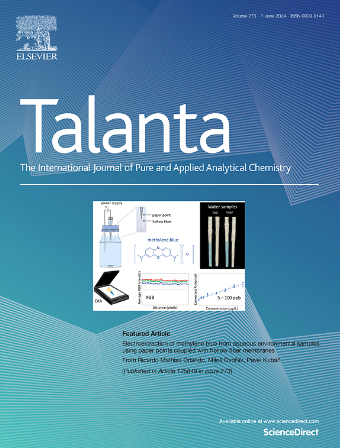Sensitive method for titanium determination in soil extract using adsorptive stripping voltammetry
IF 5.6
1区 化学
Q1 CHEMISTRY, ANALYTICAL
引用次数: 0
Abstract
Wide application of TiO2 results in contamination of the environment, and may cause adverse changes in the soil. Monitoring of soil for pollution with both solid and ionic (mobile) forms of Ti seems to be a need. Therefore, it is necessary to develop an alternative method to ICP-MS for determining ionic Ti at low concentration. Electrochemistry is particularly promising, as only the ionic form is determined, and with high precision. Adsorptive stripping voltammetry with differential pulse mode, utilizing complexation with mandelic acid supported by the catalytic effect of chlorate (V) ions, is presented here for determination of Ti in unmodified extract of soil rich in organic matter. The proposed procedure allows to detect 0.01 ng mL−1 in voltammetric cell, which gives 3 ng mL−1 for peat soil extracts (td = 240 s) with precision <1.5%. The studies indicated that 0.3 ng of Ti(IV) in cell is quantified with 100–101% recovery. The procedure optimized for such a challenging matrix can be included in complex studies of the content of ionic and solid forms of titanium compounds in soils.

求助全文
约1分钟内获得全文
求助全文
来源期刊

Talanta
化学-分析化学
CiteScore
12.30
自引率
4.90%
发文量
861
审稿时长
29 days
期刊介绍:
Talanta provides a forum for the publication of original research papers, short communications, and critical reviews in all branches of pure and applied analytical chemistry. Papers are evaluated based on established guidelines, including the fundamental nature of the study, scientific novelty, substantial improvement or advantage over existing technology or methods, and demonstrated analytical applicability. Original research papers on fundamental studies, and on novel sensor and instrumentation developments, are encouraged. Novel or improved applications in areas such as clinical and biological chemistry, environmental analysis, geochemistry, materials science and engineering, and analytical platforms for omics development are welcome.
Analytical performance of methods should be determined, including interference and matrix effects, and methods should be validated by comparison with a standard method, or analysis of a certified reference material. Simple spiking recoveries may not be sufficient. The developed method should especially comprise information on selectivity, sensitivity, detection limits, accuracy, and reliability. However, applying official validation or robustness studies to a routine method or technique does not necessarily constitute novelty. Proper statistical treatment of the data should be provided. Relevant literature should be cited, including related publications by the authors, and authors should discuss how their proposed methodology compares with previously reported methods.
 求助内容:
求助内容: 应助结果提醒方式:
应助结果提醒方式:


